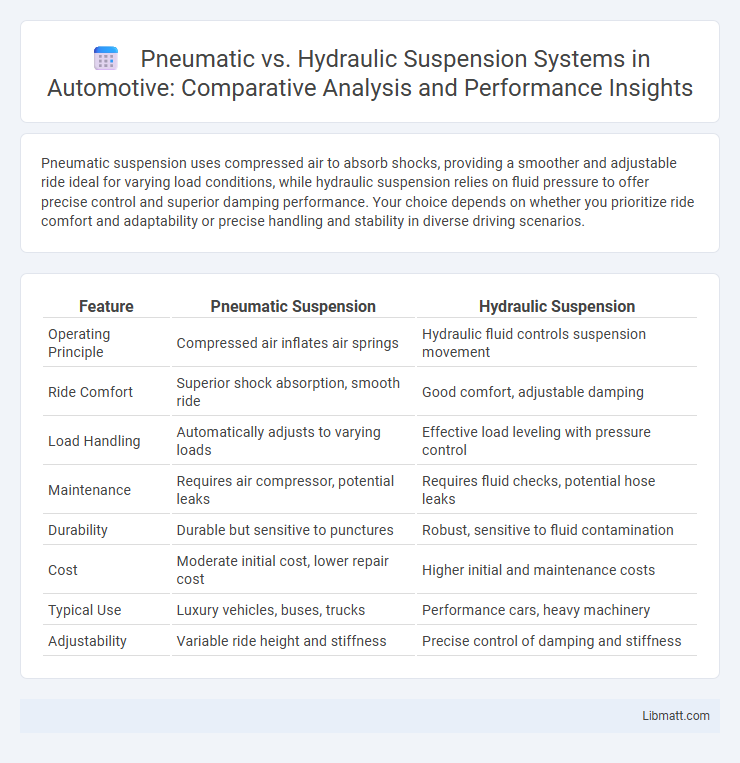Pneumatic suspension uses compressed air to absorb shocks, providing a smoother and adjustable ride ideal for varying load conditions, while hydraulic suspension relies on fluid pressure to offer precise control and superior damping performance. Your choice depends on whether you prioritize ride comfort and adaptability or precise handling and stability in diverse driving scenarios.
Table of Comparison
| Feature | Pneumatic Suspension | Hydraulic Suspension |
|---|---|---|
| Operating Principle | Compressed air inflates air springs | Hydraulic fluid controls suspension movement |
| Ride Comfort | Superior shock absorption, smooth ride | Good comfort, adjustable damping |
| Load Handling | Automatically adjusts to varying loads | Effective load leveling with pressure control |
| Maintenance | Requires air compressor, potential leaks | Requires fluid checks, potential hose leaks |
| Durability | Durable but sensitive to punctures | Robust, sensitive to fluid contamination |
| Cost | Moderate initial cost, lower repair cost | Higher initial and maintenance costs |
| Typical Use | Luxury vehicles, buses, trucks | Performance cars, heavy machinery |
| Adjustability | Variable ride height and stiffness | Precise control of damping and stiffness |
Introduction to Suspension Systems
Suspension systems are critical components in vehicles, designed to enhance ride comfort and handling by absorbing shocks from uneven road surfaces. Pneumatic suspension uses compressed air to adjust ride height and firmness, providing adaptable cushioning and improved load management. Hydraulic suspension relies on fluid pressure within cylinders to absorb impacts, offering precise control and stability in various driving conditions.
Overview of Pneumatic Suspension
Pneumatic suspension utilizes compressed air to adjust the vehicle's ride height and absorb shocks, providing enhanced comfort and stability. Its air springs replace traditional metal springs, allowing for automatic leveling regardless of load weight. This technology is widely implemented in luxury vehicles and heavy-duty trucks to improve ride quality and handling performance.
Overview of Hydraulic Suspension
Hydraulic suspension systems use fluid-filled cylinders to absorb shocks and provide smooth vehicle ride quality by adjusting the pressure within the hydraulic system. These systems offer precise control over ride height and damping, enhancing stability and handling, especially in heavy-duty and off-road vehicles. Hydraulic suspension is known for its robust performance in load leveling and durability under extreme conditions compared to traditional suspension types.
Key Components and Working Principles
Pneumatic suspension systems utilize air springs, compressors, air reservoirs, and valves to adjust vehicle height and absorb road shocks by varying air pressure within the system. Hydraulic suspension relies on hydraulic fluid, pumps, cylinders, and valves to control suspension stiffness and damping through fluid pressure adjustments. Both systems optimize ride comfort and vehicle stability but operate based on different fluid mediums--compressed air for pneumatic and pressurized hydraulic fluid for hydraulic setups.
Ride Comfort Comparison
Pneumatic suspension delivers superior ride comfort by automatically adjusting air pressure to absorb road irregularities, providing a smoother and more adaptable driving experience. Hydraulic suspension offers precise damping control and better stability under heavy loads but can be stiffer, leading to a less cushioned ride on uneven surfaces. Your choice depends on whether prioritizing adaptive comfort or handling precision is more critical for your driving needs.
Performance and Handling Differences
Pneumatic suspension offers superior ride comfort and adaptability by automatically adjusting air pressure to varying road conditions, enhancing vehicle stability and smoothness. Hydraulic suspension excels in delivering precise handling and responsiveness due to its ability to control fluid flow dynamically, making it preferred for performance-oriented driving. Your choice between the two systems will impact handling characteristics, with pneumatic systems favoring comfort and hydraulic systems prioritizing sharp, responsive control.
Maintenance and Durability
Pneumatic suspension systems require regular air pressure checks and compressor maintenance to ensure optimal performance, while hydraulic suspension demands frequent fluid inspections and seal replacements to prevent leaks. Durability of pneumatic suspension is often affected by air leaks and compressor wear, whereas hydraulic suspension may suffer from fluid contamination and cylinder corrosion over time. Your choice should consider the maintenance complexity and expected lifespan to match your vehicle's usage and reliability needs.
Cost Analysis and Affordability
Pneumatic suspension systems generally have a higher initial cost due to advanced air springs and compressors, while hydraulic suspension tends to be more affordable upfront with simpler fluid-based components. However, pneumatic suspension offers better long-term value through improved ride comfort and adaptability, potentially reducing maintenance expenses over time. Assessing your vehicle's specific needs and budget can help determine whether the superior cushioning of pneumatic suspension justifies its higher initial investment compared to the cost-effective hydraulic alternative.
Applications in Various Vehicles
Pneumatic suspension is widely used in commercial trucks, buses, and luxury vehicles for its ability to provide adjustable ride height and superior comfort over varying road conditions. Hydraulic suspension systems are common in heavy machinery, off-road vehicles, and some high-performance cars, offering excellent load-bearing capacity and precise control of damping for enhanced stability. Your choice between these systems depends on the vehicle's purpose, emphasizing ride comfort and adaptability with pneumatic, or strength and control with hydraulic suspension.
Choosing the Right Suspension System
Choosing the right suspension system depends on your vehicle's performance needs and comfort preferences. Pneumatic suspension offers adjustable ride height and smoother handling ideal for varying road conditions, while hydraulic suspension provides precise control and stronger load-bearing capacity suited for heavy-duty applications. Understanding your driving environment and vehicle usage helps tailor your suspension choice to optimize ride quality and durability.
Pneumatic Suspension vs Hydraulic Suspension Infographic

 libmatt.com
libmatt.com